Analysis of Change Management at IBM: A Comprehensive Report
VerifiedAdded on 2020/10/23
|8
|2603
|245
Report
AI Summary
This report delves into IBM's organizational changes, examining the application of Kurt Lewin's change model and its impact on the company. It analyzes IBM's culture through Hofstede's dimensions, highlighting the influence of leadership theories, including the Great Man theory, contingency theory, and situational and behavioral theories, on IBM's transformation. The report explores the correlation between leadership and change, emphasizing how leaders can motivate employees during periods of transition. Furthermore, it addresses change resistance and conflict, discussing internal and external conflicts and their implications for IBM's change initiatives. The conclusion summarizes the key findings, emphasizing the multifaceted nature of change management within IBM and the importance of considering both employee perspectives and external factors in the process.
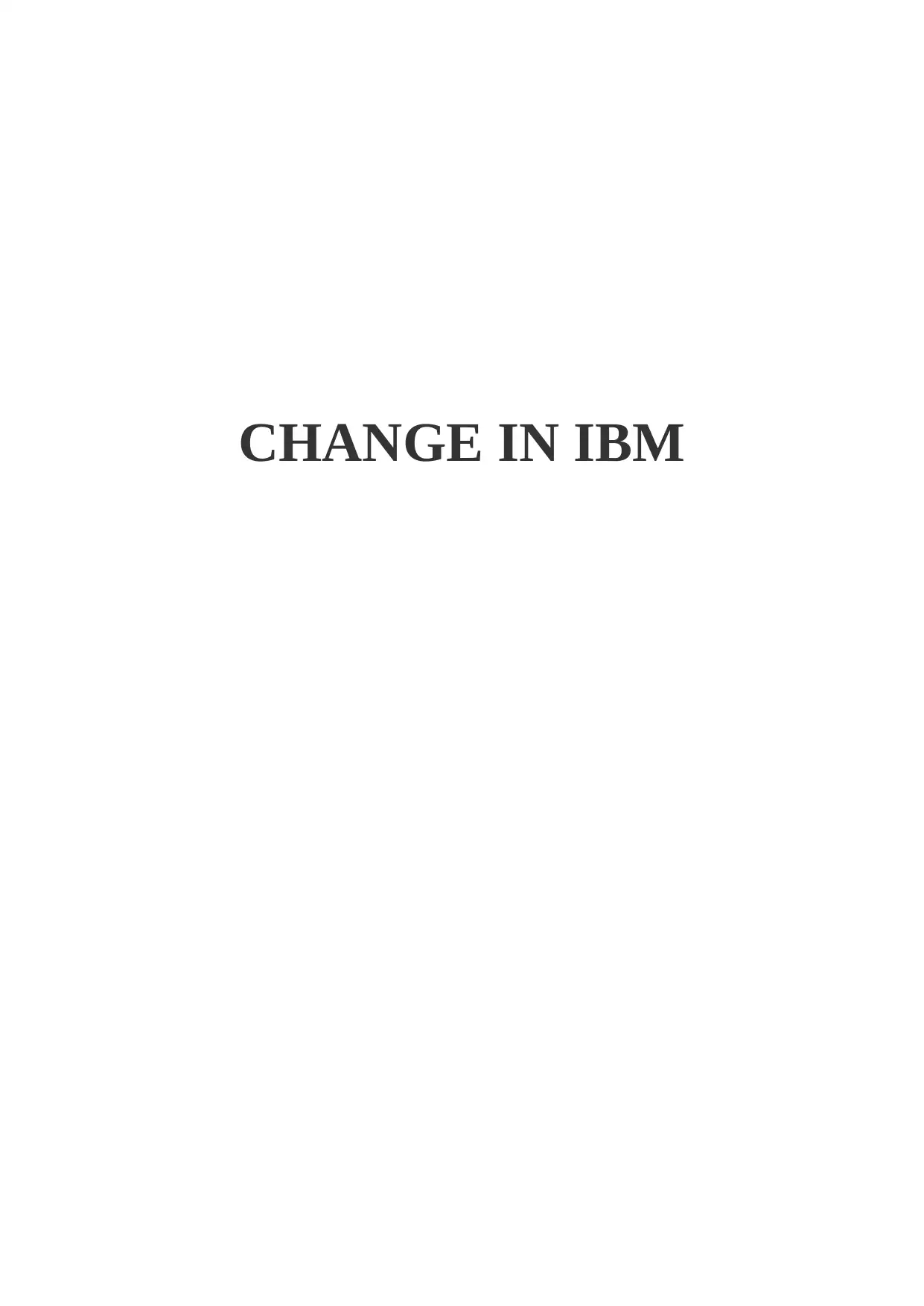
CHANGE IN IBM
Paraphrase This Document
Need a fresh take? Get an instant paraphrase of this document with our AI Paraphraser
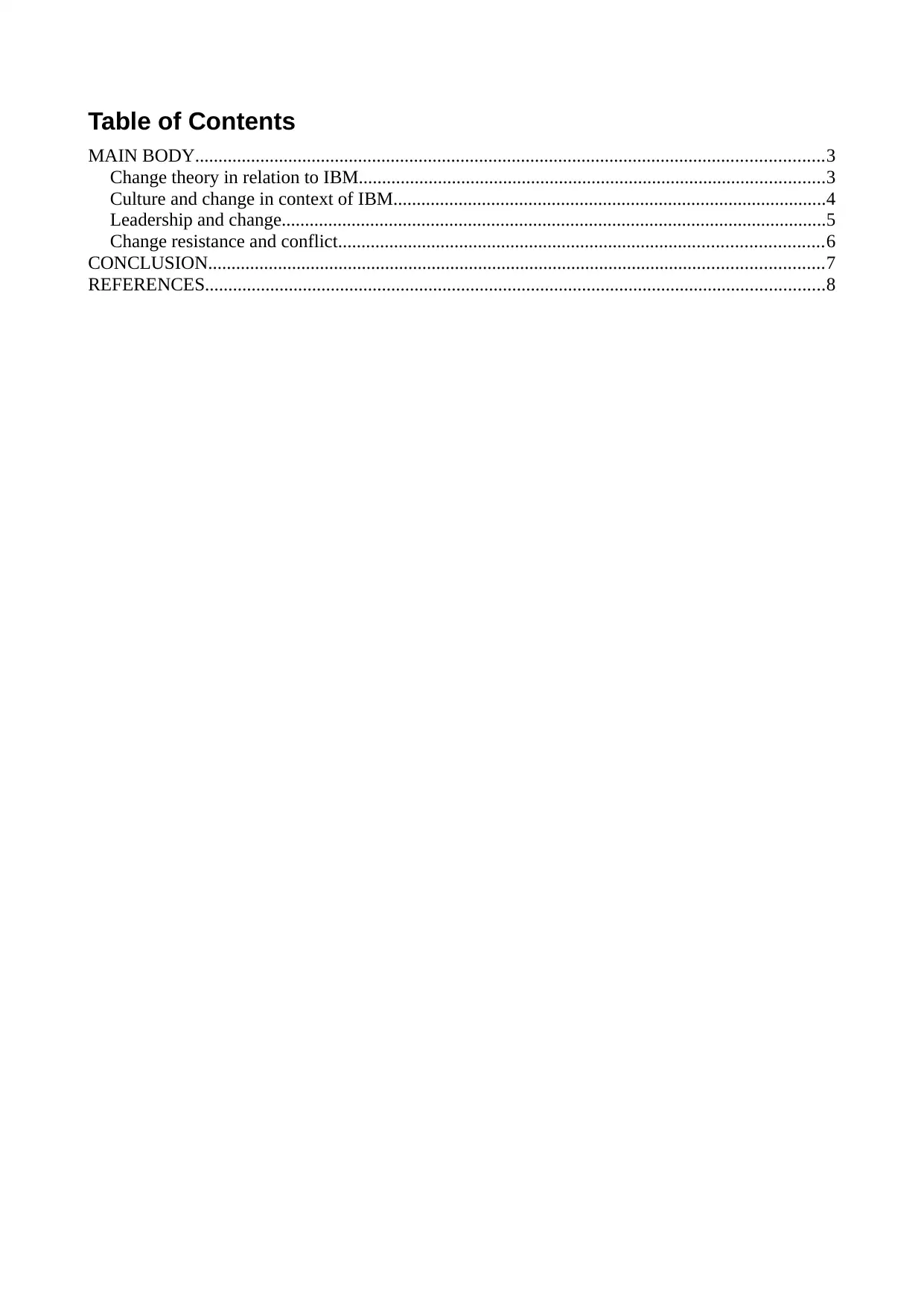
Table of Contents
MAIN BODY.......................................................................................................................................3
Change theory in relation to IBM....................................................................................................3
Culture and change in context of IBM.............................................................................................4
Leadership and change.....................................................................................................................5
Change resistance and conflict........................................................................................................6
CONCLUSION....................................................................................................................................7
REFERENCES.....................................................................................................................................8
MAIN BODY.......................................................................................................................................3
Change theory in relation to IBM....................................................................................................3
Culture and change in context of IBM.............................................................................................4
Leadership and change.....................................................................................................................5
Change resistance and conflict........................................................................................................6
CONCLUSION....................................................................................................................................7
REFERENCES.....................................................................................................................................8

INTRODUCTION
For every organisation a new strategy involves transformational change. IBM has also
introduced change. IBM is a public sector organisation which was founded in 1911 in US. Its
headquarter is situated in New york. This is Cloud computing, cognitive computing industry. IBM
manufactures computer hardware, middleware and software and also provide hosting and consulting
service in areas ranging from mainframe computer to nano technology. IBM is nicknamed big blue
due to its theme and logo. Theme relates to dress code with blue pent and white shirt. This file will
include change approaches to IBM, leadership and change, culture and change, change resistance
and conflicts in relation to IBM.
MAIN BODY
Change theory in relation to IBM
Kurt Lewin's Change Model - Lewin developed the change model with three steps unfreezing,
changing, refreezing. This model is developed for change in the organisation. Change is needed to
develop the organisation and to sustainable development. This model serves for the all other models
which relates to the change.
Unfreezing- It is the most critical stage in the change management. This stage about to motivate the
people about change and help them to get ready for change. It also involves making people aware
about the change that it is important for the organisation and also for the employees. IBM faced
many of problems in which it had to relieve the employees from organisation due to heavy loss. It
was the stage of change where IBM had to think about the change in the organisation. It is the stage
where human resource management worked for welfare of the organisation in context of employee
satisfaction and motivation(Bickel and Kryvinska, 2017). For example IBM has introduced the
change when it was about cutting the cost and reduce the staff. Then they all know about that
change will be come in IBM due to crises.
Change- It is the stage where organisation has implemented the change in the organisation. It
involves the acceptance of the new way of doing things. It is the stage where all ideas related to
change has to be implemented. IBM needed for change and they changed in the portfolio
management, in projects, programs etc. but they all efforts fail. It is critical to change in the
organisation for IBM. They made some more changes like recruitment and selection process which
is in partnership with other companies like Whirlpool, increased data efficiency and reduce the
paper work for save the time, used intuitive and integrated HR applications which eliminate the
risk. Managers started spent their mostly time with the employees and helped them in problem
For every organisation a new strategy involves transformational change. IBM has also
introduced change. IBM is a public sector organisation which was founded in 1911 in US. Its
headquarter is situated in New york. This is Cloud computing, cognitive computing industry. IBM
manufactures computer hardware, middleware and software and also provide hosting and consulting
service in areas ranging from mainframe computer to nano technology. IBM is nicknamed big blue
due to its theme and logo. Theme relates to dress code with blue pent and white shirt. This file will
include change approaches to IBM, leadership and change, culture and change, change resistance
and conflicts in relation to IBM.
MAIN BODY
Change theory in relation to IBM
Kurt Lewin's Change Model - Lewin developed the change model with three steps unfreezing,
changing, refreezing. This model is developed for change in the organisation. Change is needed to
develop the organisation and to sustainable development. This model serves for the all other models
which relates to the change.
Unfreezing- It is the most critical stage in the change management. This stage about to motivate the
people about change and help them to get ready for change. It also involves making people aware
about the change that it is important for the organisation and also for the employees. IBM faced
many of problems in which it had to relieve the employees from organisation due to heavy loss. It
was the stage of change where IBM had to think about the change in the organisation. It is the stage
where human resource management worked for welfare of the organisation in context of employee
satisfaction and motivation(Bickel and Kryvinska, 2017). For example IBM has introduced the
change when it was about cutting the cost and reduce the staff. Then they all know about that
change will be come in IBM due to crises.
Change- It is the stage where organisation has implemented the change in the organisation. It
involves the acceptance of the new way of doing things. It is the stage where all ideas related to
change has to be implemented. IBM needed for change and they changed in the portfolio
management, in projects, programs etc. but they all efforts fail. It is critical to change in the
organisation for IBM. They made some more changes like recruitment and selection process which
is in partnership with other companies like Whirlpool, increased data efficiency and reduce the
paper work for save the time, used intuitive and integrated HR applications which eliminate the
risk. Managers started spent their mostly time with the employees and helped them in problem
⊘ This is a preview!⊘
Do you want full access?
Subscribe today to unlock all pages.

Trusted by 1+ million students worldwide
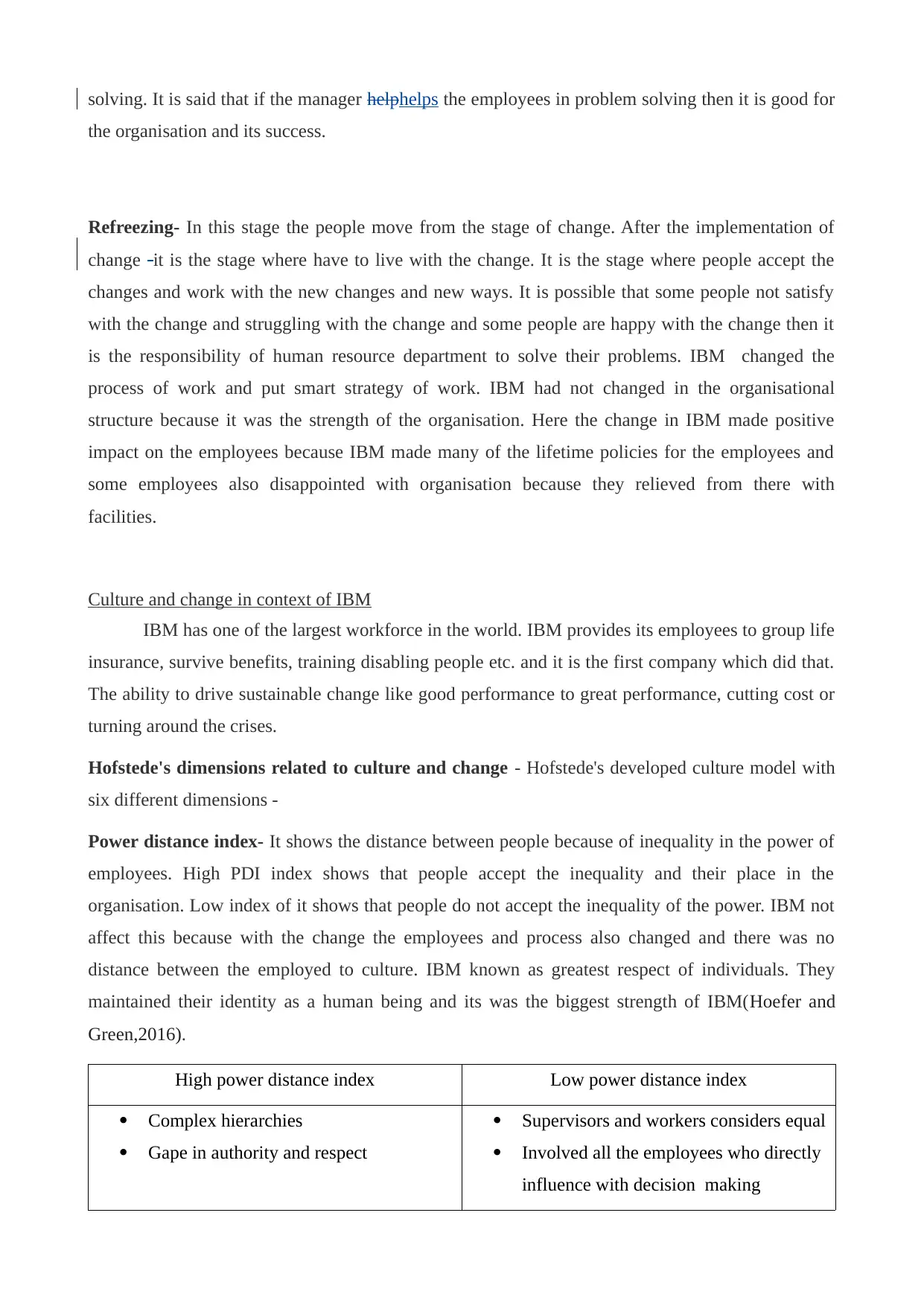
solving. It is said that if the manager helphelps the employees in problem solving then it is good for
the organisation and its success.
Refreezing- In this stage the people move from the stage of change. After the implementation of
change it is the stage where have to live with the change. It is the stage where people accept the
changes and work with the new changes and new ways. It is possible that some people not satisfy
with the change and struggling with the change and some people are happy with the change then it
is the responsibility of human resource department to solve their problems. IBM changed the
process of work and put smart strategy of work. IBM had not changed in the organisational
structure because it was the strength of the organisation. Here the change in IBM made positive
impact on the employees because IBM made many of the lifetime policies for the employees and
some employees also disappointed with organisation because they relieved from there with
facilities.
Culture and change in context of IBM
IBM has one of the largest workforce in the world. IBM provides its employees to group life
insurance, survive benefits, training disabling people etc. and it is the first company which did that.
The ability to drive sustainable change like good performance to great performance, cutting cost or
turning around the crises.
Hofstede's dimensions related to culture and change - Hofstede's developed culture model with
six different dimensions -
Power distance index- It shows the distance between people because of inequality in the power of
employees. High PDI index shows that people accept the inequality and their place in the
organisation. Low index of it shows that people do not accept the inequality of the power. IBM not
affect this because with the change the employees and process also changed and there was no
distance between the employed to culture. IBM known as greatest respect of individuals. They
maintained their identity as a human being and its was the biggest strength of IBM(Hoefer and
Green,2016).
High power distance index Low power distance index
Complex hierarchies
Gape in authority and respect
Supervisors and workers considers equal
Involved all the employees who directly
influence with decision making
the organisation and its success.
Refreezing- In this stage the people move from the stage of change. After the implementation of
change it is the stage where have to live with the change. It is the stage where people accept the
changes and work with the new changes and new ways. It is possible that some people not satisfy
with the change and struggling with the change and some people are happy with the change then it
is the responsibility of human resource department to solve their problems. IBM changed the
process of work and put smart strategy of work. IBM had not changed in the organisational
structure because it was the strength of the organisation. Here the change in IBM made positive
impact on the employees because IBM made many of the lifetime policies for the employees and
some employees also disappointed with organisation because they relieved from there with
facilities.
Culture and change in context of IBM
IBM has one of the largest workforce in the world. IBM provides its employees to group life
insurance, survive benefits, training disabling people etc. and it is the first company which did that.
The ability to drive sustainable change like good performance to great performance, cutting cost or
turning around the crises.
Hofstede's dimensions related to culture and change - Hofstede's developed culture model with
six different dimensions -
Power distance index- It shows the distance between people because of inequality in the power of
employees. High PDI index shows that people accept the inequality and their place in the
organisation. Low index of it shows that people do not accept the inequality of the power. IBM not
affect this because with the change the employees and process also changed and there was no
distance between the employed to culture. IBM known as greatest respect of individuals. They
maintained their identity as a human being and its was the biggest strength of IBM(Hoefer and
Green,2016).
High power distance index Low power distance index
Complex hierarchies
Gape in authority and respect
Supervisors and workers considers equal
Involved all the employees who directly
influence with decision making
Paraphrase This Document
Need a fresh take? Get an instant paraphrase of this document with our AI Paraphraser
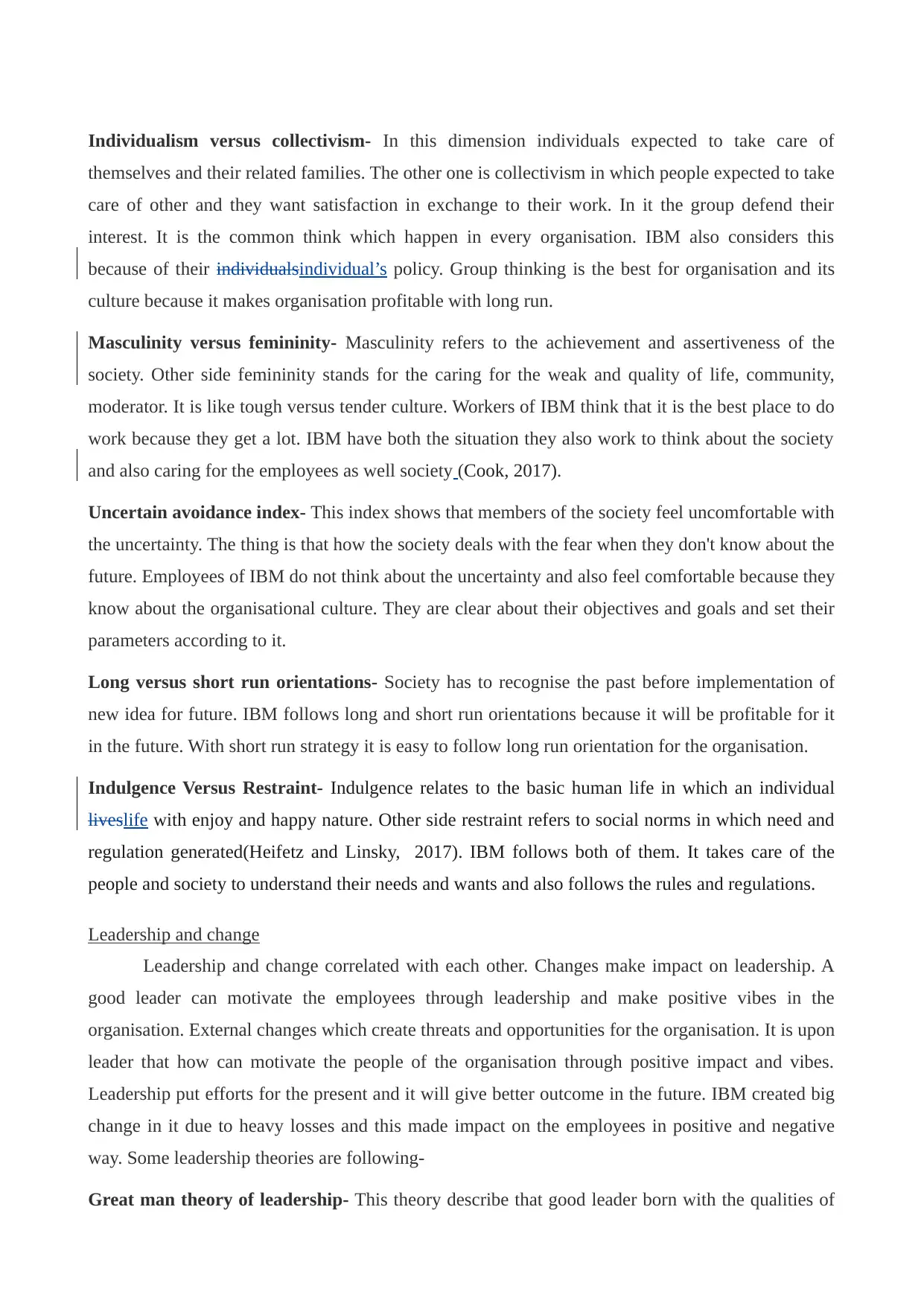
Individualism versus collectivism- In this dimension individuals expected to take care of
themselves and their related families. The other one is collectivism in which people expected to take
care of other and they want satisfaction in exchange to their work. In it the group defend their
interest. It is the common think which happen in every organisation. IBM also considers this
because of their individualsindividual’s policy. Group thinking is the best for organisation and its
culture because it makes organisation profitable with long run.
Masculinity versus femininity- Masculinity refers to the achievement and assertiveness of the
society. Other side femininity stands for the caring for the weak and quality of life, community,
moderator. It is like tough versus tender culture. Workers of IBM think that it is the best place to do
work because they get a lot. IBM have both the situation they also work to think about the society
and also caring for the employees as well society (Cook, 2017).
Uncertain avoidance index- This index shows that members of the society feel uncomfortable with
the uncertainty. The thing is that how the society deals with the fear when they don't know about the
future. Employees of IBM do not think about the uncertainty and also feel comfortable because they
know about the organisational culture. They are clear about their objectives and goals and set their
parameters according to it.
Long versus short run orientations- Society has to recognise the past before implementation of
new idea for future. IBM follows long and short run orientations because it will be profitable for it
in the future. With short run strategy it is easy to follow long run orientation for the organisation.
Indulgence Versus Restraint- Indulgence relates to the basic human life in which an individual
liveslife with enjoy and happy nature. Other side restraint refers to social norms in which need and
regulation generated(Heifetz and Linsky, 2017). IBM follows both of them. It takes care of the
people and society to understand their needs and wants and also follows the rules and regulations.
Leadership and change
Leadership and change correlated with each other. Changes make impact on leadership. A
good leader can motivate the employees through leadership and make positive vibes in the
organisation. External changes which create threats and opportunities for the organisation. It is upon
leader that how can motivate the people of the organisation through positive impact and vibes.
Leadership put efforts for the present and it will give better outcome in the future. IBM created big
change in it due to heavy losses and this made impact on the employees in positive and negative
way. Some leadership theories are following-
Great man theory of leadership- This theory describe that good leader born with the qualities of
themselves and their related families. The other one is collectivism in which people expected to take
care of other and they want satisfaction in exchange to their work. In it the group defend their
interest. It is the common think which happen in every organisation. IBM also considers this
because of their individualsindividual’s policy. Group thinking is the best for organisation and its
culture because it makes organisation profitable with long run.
Masculinity versus femininity- Masculinity refers to the achievement and assertiveness of the
society. Other side femininity stands for the caring for the weak and quality of life, community,
moderator. It is like tough versus tender culture. Workers of IBM think that it is the best place to do
work because they get a lot. IBM have both the situation they also work to think about the society
and also caring for the employees as well society (Cook, 2017).
Uncertain avoidance index- This index shows that members of the society feel uncomfortable with
the uncertainty. The thing is that how the society deals with the fear when they don't know about the
future. Employees of IBM do not think about the uncertainty and also feel comfortable because they
know about the organisational culture. They are clear about their objectives and goals and set their
parameters according to it.
Long versus short run orientations- Society has to recognise the past before implementation of
new idea for future. IBM follows long and short run orientations because it will be profitable for it
in the future. With short run strategy it is easy to follow long run orientation for the organisation.
Indulgence Versus Restraint- Indulgence relates to the basic human life in which an individual
liveslife with enjoy and happy nature. Other side restraint refers to social norms in which need and
regulation generated(Heifetz and Linsky, 2017). IBM follows both of them. It takes care of the
people and society to understand their needs and wants and also follows the rules and regulations.
Leadership and change
Leadership and change correlated with each other. Changes make impact on leadership. A
good leader can motivate the employees through leadership and make positive vibes in the
organisation. External changes which create threats and opportunities for the organisation. It is upon
leader that how can motivate the people of the organisation through positive impact and vibes.
Leadership put efforts for the present and it will give better outcome in the future. IBM created big
change in it due to heavy losses and this made impact on the employees in positive and negative
way. Some leadership theories are following-
Great man theory of leadership- This theory describe that good leader born with the qualities of
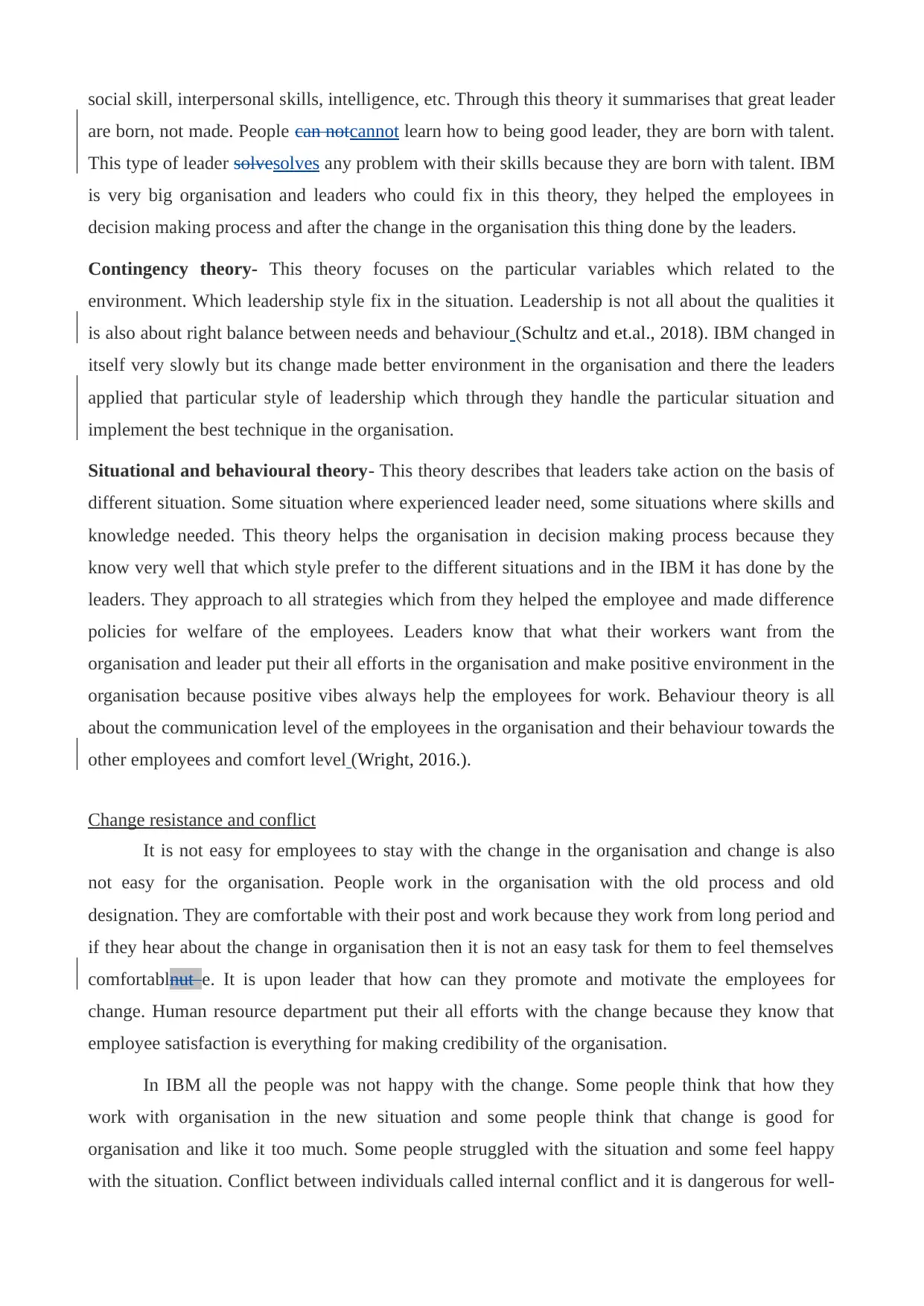
social skill, interpersonal skills, intelligence, etc. Through this theory it summarises that great leader
are born, not made. People can notcannot learn how to being good leader, they are born with talent.
This type of leader solvesolves any problem with their skills because they are born with talent. IBM
is very big organisation and leaders who could fix in this theory, they helped the employees in
decision making process and after the change in the organisation this thing done by the leaders.
Contingency theory- This theory focuses on the particular variables which related to the
environment. Which leadership style fix in the situation. Leadership is not all about the qualities it
is also about right balance between needs and behaviour (Schultz and et.al., 2018). IBM changed in
itself very slowly but its change made better environment in the organisation and there the leaders
applied that particular style of leadership which through they handle the particular situation and
implement the best technique in the organisation.
Situational and behavioural theory- This theory describes that leaders take action on the basis of
different situation. Some situation where experienced leader need, some situations where skills and
knowledge needed. This theory helps the organisation in decision making process because they
know very well that which style prefer to the different situations and in the IBM it has done by the
leaders. They approach to all strategies which from they helped the employee and made difference
policies for welfare of the employees. Leaders know that what their workers want from the
organisation and leader put their all efforts in the organisation and make positive environment in the
organisation because positive vibes always help the employees for work. Behaviour theory is all
about the communication level of the employees in the organisation and their behaviour towards the
other employees and comfort level (Wright, 2016.).
Change resistance and conflict
It is not easy for employees to stay with the change in the organisation and change is also
not easy for the organisation. People work in the organisation with the old process and old
designation. They are comfortable with their post and work because they work from long period and
if they hear about the change in organisation then it is not an easy task for them to feel themselves
comfortablnut e. It is upon leader that how can they promote and motivate the employees for
change. Human resource department put their all efforts with the change because they know that
employee satisfaction is everything for making credibility of the organisation.
In IBM all the people was not happy with the change. Some people think that how they
work with organisation in the new situation and some people think that change is good for
organisation and like it too much. Some people struggled with the situation and some feel happy
with the situation. Conflict between individuals called internal conflict and it is dangerous for well-
are born, not made. People can notcannot learn how to being good leader, they are born with talent.
This type of leader solvesolves any problem with their skills because they are born with talent. IBM
is very big organisation and leaders who could fix in this theory, they helped the employees in
decision making process and after the change in the organisation this thing done by the leaders.
Contingency theory- This theory focuses on the particular variables which related to the
environment. Which leadership style fix in the situation. Leadership is not all about the qualities it
is also about right balance between needs and behaviour (Schultz and et.al., 2018). IBM changed in
itself very slowly but its change made better environment in the organisation and there the leaders
applied that particular style of leadership which through they handle the particular situation and
implement the best technique in the organisation.
Situational and behavioural theory- This theory describes that leaders take action on the basis of
different situation. Some situation where experienced leader need, some situations where skills and
knowledge needed. This theory helps the organisation in decision making process because they
know very well that which style prefer to the different situations and in the IBM it has done by the
leaders. They approach to all strategies which from they helped the employee and made difference
policies for welfare of the employees. Leaders know that what their workers want from the
organisation and leader put their all efforts in the organisation and make positive environment in the
organisation because positive vibes always help the employees for work. Behaviour theory is all
about the communication level of the employees in the organisation and their behaviour towards the
other employees and comfort level (Wright, 2016.).
Change resistance and conflict
It is not easy for employees to stay with the change in the organisation and change is also
not easy for the organisation. People work in the organisation with the old process and old
designation. They are comfortable with their post and work because they work from long period and
if they hear about the change in organisation then it is not an easy task for them to feel themselves
comfortablnut e. It is upon leader that how can they promote and motivate the employees for
change. Human resource department put their all efforts with the change because they know that
employee satisfaction is everything for making credibility of the organisation.
In IBM all the people was not happy with the change. Some people think that how they
work with organisation in the new situation and some people think that change is good for
organisation and like it too much. Some people struggled with the situation and some feel happy
with the situation. Conflict between individuals called internal conflict and it is dangerous for well-
⊘ This is a preview!⊘
Do you want full access?
Subscribe today to unlock all pages.

Trusted by 1+ million students worldwide
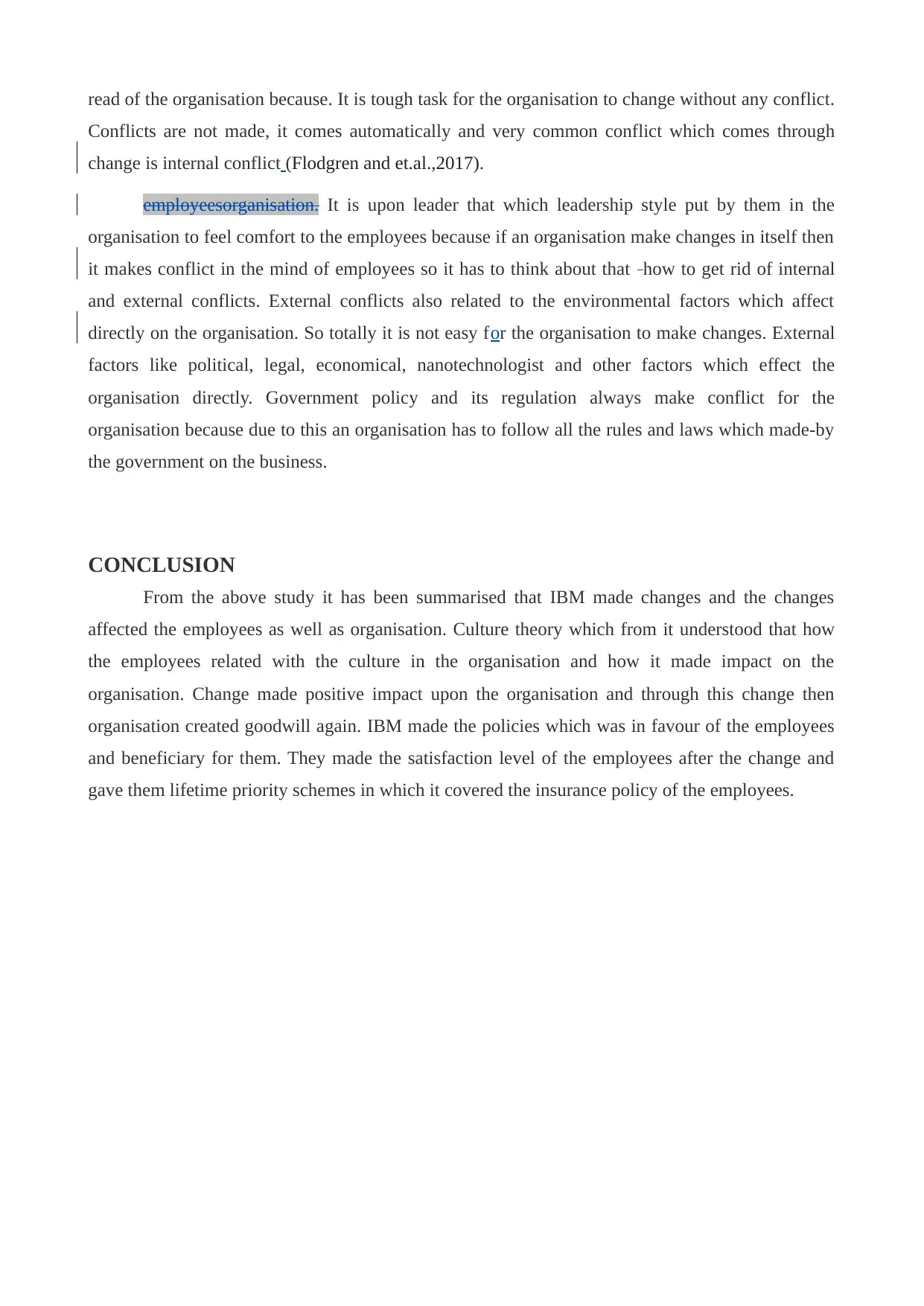
read of the organisation because. It is tough task for the organisation to change without any conflict.
Conflicts are not made, it comes automatically and very common conflict which comes through
change is internal conflict (Flodgren and et.al.,2017).
employeesorganisation. It is upon leader that which leadership style put by them in the
organisation to feel comfort to the employees because if an organisation make changes in itself then
it makes conflict in the mind of employees so it has to think about that how to get rid of internal
and external conflicts. External conflicts also related to the environmental factors which affect
directly on the organisation. So totally it is not easy for the organisation to make changes. External
factors like political, legal, economical, nanotechnologist and other factors which effect the
organisation directly. Government policy and its regulation always make conflict for the
organisation because due to this an organisation has to follow all the rules and laws which made-by
the government on the business.
CONCLUSION
From the above study it has been summarised that IBM made changes and the changes
affected the employees as well as organisation. Culture theory which from it understood that how
the employees related with the culture in the organisation and how it made impact on the
organisation. Change made positive impact upon the organisation and through this change then
organisation created goodwill again. IBM made the policies which was in favour of the employees
and beneficiary for them. They made the satisfaction level of the employees after the change and
gave them lifetime priority schemes in which it covered the insurance policy of the employees.
Conflicts are not made, it comes automatically and very common conflict which comes through
change is internal conflict (Flodgren and et.al.,2017).
employeesorganisation. It is upon leader that which leadership style put by them in the
organisation to feel comfort to the employees because if an organisation make changes in itself then
it makes conflict in the mind of employees so it has to think about that how to get rid of internal
and external conflicts. External conflicts also related to the environmental factors which affect
directly on the organisation. So totally it is not easy for the organisation to make changes. External
factors like political, legal, economical, nanotechnologist and other factors which effect the
organisation directly. Government policy and its regulation always make conflict for the
organisation because due to this an organisation has to follow all the rules and laws which made-by
the government on the business.
CONCLUSION
From the above study it has been summarised that IBM made changes and the changes
affected the employees as well as organisation. Culture theory which from it understood that how
the employees related with the culture in the organisation and how it made impact on the
organisation. Change made positive impact upon the organisation and through this change then
organisation created goodwill again. IBM made the policies which was in favour of the employees
and beneficiary for them. They made the satisfaction level of the employees after the change and
gave them lifetime priority schemes in which it covered the insurance policy of the employees.
Paraphrase This Document
Need a fresh take? Get an instant paraphrase of this document with our AI Paraphraser
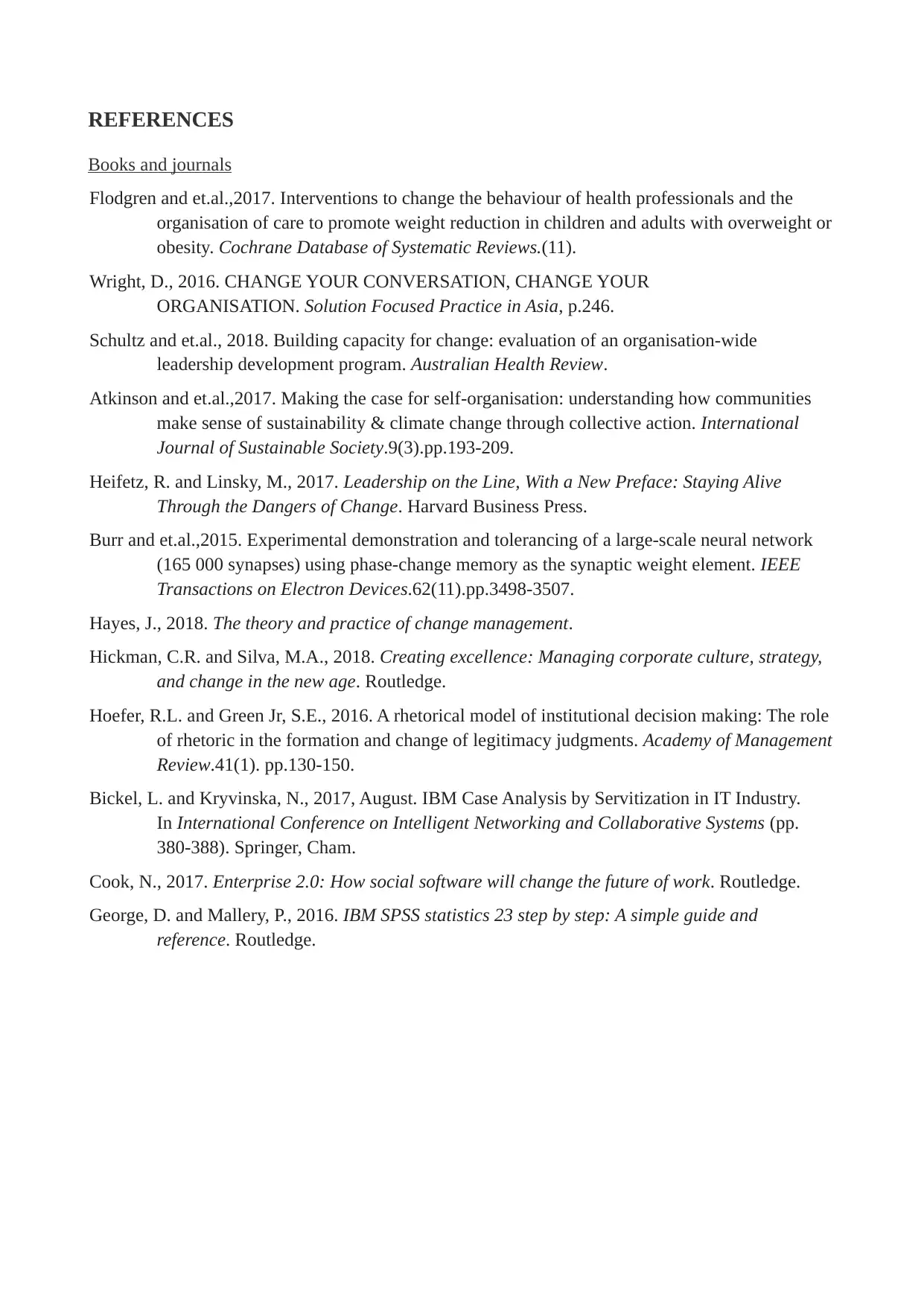
REFERENCES
Books and journals
Flodgren and et.al.,2017. Interventions to change the behaviour of health professionals and the
organisation of care to promote weight reduction in children and adults with overweight or
obesity. Cochrane Database of Systematic Reviews.(11).
Wright, D., 2016. CHANGE YOUR CONVERSATION, CHANGE YOUR
ORGANISATION. Solution Focused Practice in Asia, p.246.
Schultz and et.al., 2018. Building capacity for change: evaluation of an organisation-wide
leadership development program. Australian Health Review.
Atkinson and et.al.,2017. Making the case for self-organisation: understanding how communities
make sense of sustainability & climate change through collective action. International
Journal of Sustainable Society.9(3).pp.193-209.
Heifetz, R. and Linsky, M., 2017. Leadership on the Line, With a New Preface: Staying Alive
Through the Dangers of Change. Harvard Business Press.
Burr and et.al.,2015. Experimental demonstration and tolerancing of a large-scale neural network
(165 000 synapses) using phase-change memory as the synaptic weight element. IEEE
Transactions on Electron Devices.62(11).pp.3498-3507.
Hayes, J., 2018. The theory and practice of change management.
Hickman, C.R. and Silva, M.A., 2018. Creating excellence: Managing corporate culture, strategy,
and change in the new age. Routledge.
Hoefer, R.L. and Green Jr, S.E., 2016. A rhetorical model of institutional decision making: The role
of rhetoric in the formation and change of legitimacy judgments. Academy of Management
Review.41(1). pp.130-150.
Bickel, L. and Kryvinska, N., 2017, August. IBM Case Analysis by Servitization in IT Industry.
In International Conference on Intelligent Networking and Collaborative Systems (pp.
380-388). Springer, Cham.
Cook, N., 2017. Enterprise 2.0: How social software will change the future of work. Routledge.
George, D. and Mallery, P., 2016. IBM SPSS statistics 23 step by step: A simple guide and
reference. Routledge.
Books and journals
Flodgren and et.al.,2017. Interventions to change the behaviour of health professionals and the
organisation of care to promote weight reduction in children and adults with overweight or
obesity. Cochrane Database of Systematic Reviews.(11).
Wright, D., 2016. CHANGE YOUR CONVERSATION, CHANGE YOUR
ORGANISATION. Solution Focused Practice in Asia, p.246.
Schultz and et.al., 2018. Building capacity for change: evaluation of an organisation-wide
leadership development program. Australian Health Review.
Atkinson and et.al.,2017. Making the case for self-organisation: understanding how communities
make sense of sustainability & climate change through collective action. International
Journal of Sustainable Society.9(3).pp.193-209.
Heifetz, R. and Linsky, M., 2017. Leadership on the Line, With a New Preface: Staying Alive
Through the Dangers of Change. Harvard Business Press.
Burr and et.al.,2015. Experimental demonstration and tolerancing of a large-scale neural network
(165 000 synapses) using phase-change memory as the synaptic weight element. IEEE
Transactions on Electron Devices.62(11).pp.3498-3507.
Hayes, J., 2018. The theory and practice of change management.
Hickman, C.R. and Silva, M.A., 2018. Creating excellence: Managing corporate culture, strategy,
and change in the new age. Routledge.
Hoefer, R.L. and Green Jr, S.E., 2016. A rhetorical model of institutional decision making: The role
of rhetoric in the formation and change of legitimacy judgments. Academy of Management
Review.41(1). pp.130-150.
Bickel, L. and Kryvinska, N., 2017, August. IBM Case Analysis by Servitization in IT Industry.
In International Conference on Intelligent Networking and Collaborative Systems (pp.
380-388). Springer, Cham.
Cook, N., 2017. Enterprise 2.0: How social software will change the future of work. Routledge.
George, D. and Mallery, P., 2016. IBM SPSS statistics 23 step by step: A simple guide and
reference. Routledge.
1 out of 8
Related Documents
Your All-in-One AI-Powered Toolkit for Academic Success.
+13062052269
info@desklib.com
Available 24*7 on WhatsApp / Email
![[object Object]](/_next/static/media/star-bottom.7253800d.svg)
Unlock your academic potential
Copyright © 2020–2025 A2Z Services. All Rights Reserved. Developed and managed by ZUCOL.




